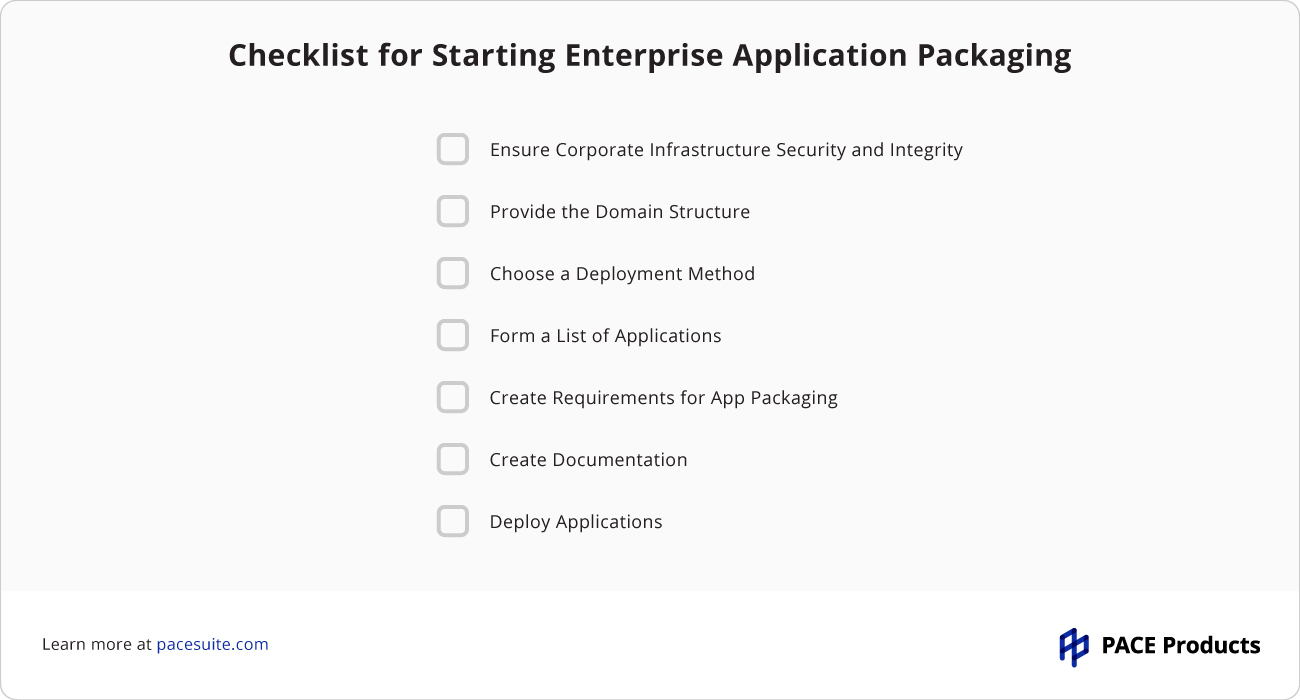From Zero to Hero: 7 Steps to Get Started with Enterprise Application Packaging
Enterprises around the globe use a staggering amount of applications to meet all their needs and reach objectives. For instance, in 2021, according to the Cloud Security Alliance report, the number of custom applications run by the average enterprise was 464.
Application packaging allows you to install applications for all enterprise users quickly and efficiently to run business processes. However, to ensure efficient app packaging within an enterprise, you must have all the prerequisites for its success.
This article will guide you through all the initial stages needed to start application packaging at your organization.
What is an Enterprise Application?
Before moving on to the steps of enterprise application packaging, let’s see what an enterprise application is. In short, an enterprise app is a software platform created to operate in the business environment to meet the specific needs of a large organization.
Managing applications, especially those that need packaging services, requires centralized management to allow fast arrangement and distribution of packages across the entire organization. The following steps create a solid foundation for adequate enterprise application packaging.
Step 1 — Ensure Corporate Infrastructure Security and Integrity
To start, you should ensure all your end-user devices are up and running correctly. Try to standardize your pool of operating systems as much as possible. Try to standardize your pool of operating systems as much as possible.
However, security is the real issue you must take care of at this stage. In 2022, 82% of all data breaches occurred due to human factors, including errors and access misuse caused by end-users. Such a security violation leads to dire consequences as, for instance, the US business market alone loses, on average, $9.44M because of data breaches.
This is why all your corporate users should have as fewer admin rights as possible. By restricting the usage of administrator accounts, you are securing your systems by limiting the number of users with too much power to make changes to those systems and significantly reducing human errors.
Step 2 — Provide the Domain Structure
If your organization uses a Microsoft operating system, there are some core information technology components that you need to employ to guarantee efficient enterprise application packaging. A few such core elements are a domain, an active directory, and a domain controller, which together create a domain structure of your organization.
Active Directory (AD) is a component of the MS software environment and an access control tool used to manage an organization’s users, applications, and resources by effectively handling the authorization and authentication of users to network resources.
The main benefits of AD include the centralized storage of users, apps, and resources data, the facilitation of security through setting permissions to the right users, minimizing data replication, etc.
Domain Controller (DC) is a server that handles user authentication requests for a particular domain within a company’s network. It authenticates and authorizes users based on their login credentials to access enterprise resources within a domain. In MS Windows, the domain controller obtains authentication information directly from Active Directory.
Step 3 — Choose a Deployment Method
Managing all the devices used to access organization resources becomes a great challenge for multiple enterprises. For the company to be successful, it must ensure that its employees have access to applications securely, together with the ability to collaborate and work from anywhere. In addition to protecting organization data and managing end-user access, administrators are responsible for supporting their users across all locations.
Corporate applications can be distributed more rapidly and easily since the software does not have to be manually installed and configured on each computer or mobile device. For this purpose, an enterprise needs to use a solution to help handle the management, deployment, and security of devices and applications across an enterprise. Thus, you can opt for Microsoft Intune, Microsoft System Center Configuration Manager (SCCM), or any other third-party solution.
Besides, such tools can help you optimize your admin personnel and, as a result, reduce maintenance costs.
An application packaging tool PACE Suite allows you quickly deploy your packager into Microsoft System Center Configuration Manager. Learn more about how to do it in the article “Deploying MSI package to SCCM.”
Step 4 — Form a List of Applications
During this stage, you need to form a pool of all your applications that will be deployed in the system. It means you need to know what apps you will install on the user’s device, office applications, browsers, etc.
Step 5 — Create Requirements for App Packaging
Even if you decide to partner with a third-party application packaging service provider, you still need to use your requirements to guide them through.
In the requirements, you must include valuable information. For instance, you can indicate that you don’t want to include updates in your applications or have desktop shortcuts, as well as say that applications should be (or shouldn’t be) deployed as MSI or, on the contrary, should be installed as MSIX, etc. The list can be pretty detailed. So, try to form the packaging rules in Step 5.
Step 6 — Create Documentation
It is necessary to create documentation for each application you intend to package. Simply speaking, application documentation is written material, images, or video instructions that come along with software.
You should indicate how this application must be installed, what format you prefer for repackaging, and any specific settings if your app needs some specific configuration. Thus, at this stage, you create installation instructions for each application.
One of the best practices of enterprise application packaging is to include application owners in documentation, someone who’s quite knowledgeable about the application and knows how it works.
You can use PACE Suite’s Docu Generator to automatically create a nice-looking document with screenshots and annotations based on your on-screen actions.
This module of PACE Suite allows you to save your document in three formats:
- Word Document — screenshots and annotations will be saved as DOC files;
- MHT/HTML File — the screenshots and annotations will be saved as HTML files (Web pages) or MHT files (Web archives);
- Docu Generator Scenario — the scenario will be saved in Docu Generator’s internal format (DSCN file), which can be converted to an output document with Docu Generator.
Step 7 — Deploy Applications
Once the pool of applications has been created and installation instructions have been provided, the sources can be given to the packaging engineers or your third-party partner. Hence, it’ll allow you to have more control of the process.
Your application packaging engineer will verify the sources to provide you with more reliable and secure packages. After creating the package, you can finally deploy it into your system.
Setup Your Application Packaging Process
To make the most out of your enterprise application packaging, you can start automating app packaging processes within your organization with PACE Suite. Automation will allow you to reach three main objectives:
- Faster delivery time of apps to end-users;
- Elimination of human errors;
- Bringing more revenue while cutting costs.
One of the valuable tools that can help you manage application packaging workflow at your company is PACE Packager Hub. It’s an intelligent workflow management platform that serves as a single point for package order management, order history tracking, team workload monitoring, and repository management.
PACE Packager Hub, as an enterprise project management software, enables you to perform the following:
- Set up the entire end-to-end packaging process;
- Use in-built best practices packaging processes with high customization options;
- Connect customers and your app packaging team for smoother and better servicing;
- Meet all service-level agreements;
- Keep a 360-degree view of all your app packaging projects.
Wrapping Up
It’s always challenging to build something from the ground up. Especially when you don’t know where to begin, however, the process described here is something you can rely on. All the steps described in the article, from ensuring corporate infrastructure security and integrity to deploying applications, will help you to get started with enterprise application packaging at your organization.











